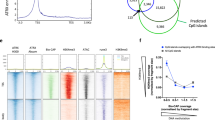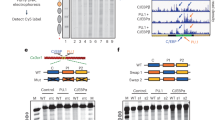Abstract
The function of the subnuclear structure the promyelocytic leukaemia (PML) body is unclear largely because of the functional heterogeneity of its constituents. Here, we provide the evidence for a direct link between PML, higher-order chromatin organization and gene regulation. We show that PML physically and functionally interacts with the matrix attachment region (MAR)-binding protein, special AT-rich sequence binding protein 1 (SATB1) to organize the major histocompatibility complex (MHC) class I locus into distinct higher-order chromatin-loop structures. Interferon γ (IFNγ) treatment and silencing of either SATB1 or PML dynamically alter chromatin architecture, thus affecting the expression profile of a subset of MHC class I genes. Our studies identify PML and SATB1 as a regulatory complex that governs transcription by orchestrating dynamic chromatin-loop architecture.
This is a preview of subscription content, access via your institution
Access options
Subscribe to this journal
Receive 12 print issues and online access
$209.00 per year
only $17.42 per issue
Buy this article
- Purchase on Springer Link
- Instant access to full article PDF
Prices may be subject to local taxes which are calculated during checkout








Similar content being viewed by others
References
Spector, D. L. The dynamics of chromosome organization and gene regulation. Annu. Rev. Biochem. 72, 573–608 (2003).
Cai, S., Han, H. J. & Kohwi-Shigematsu, T. Tissue-specific nuclear architecture and gene expression regulated by SATB1. Nature Genet. 34, 42–51 (2003).
Yasui, D., Miyano, M., Cai, S., Varga-Weisz, P. & Kohwi-Shigematsu, T. SATB1 targets chromatin remodelling to regulate genes over long distances. Nature 419, 641–645 (2002).
Kumar, P. P., Purbey, P. K., Ravi, D. S., Mitra, D. & Galande S. Displacement of SATB1-bound histone deacetylase 1 corepressor by the human immunodeficiency virus type 1 transactivator induces expression of interleukin-2 and its receptor in T cells. Mol. Cell Biol. 25, 1620–1633 (2005).
Galande, S., Dickinson, L. A., Mian, I. S., Sikorska, M. & Kohwi-Shigematsu, T. SATB1 cleavage by caspase 6 disrupts PDZ domain-mediated dimerization, causing detachment from chromatin early in T-cell apoptosis. Mol. Cell Biol. 21, 5591–5604 (2001).
Dickinson, L. A., Dickinson, C. D. & Kohwi-Shigematsu, T. An atypical homeodomain in SATB1 promotes specific recognition of the key structural element in a matrix attachment region. J. Biol. Chem. 272, 11463–11470 (1997).
Jensen, K., Shiels, C. & Freemont, P. S. PML protein isoforms and the RBCC/TRIM motif. Oncogene 20, 7223–7233 (2001).
Seeler, J. S. & Dejean, A. Nuclear and unclear functions of SUMO. Nature Rev. Mol. Cell Biol. 4, 690–699 (2003).
Zhong, S. et al. Role of SUMO-1-modified PML in nuclear body formation. Blood 95, 2748–2752 (2000).
Shiels, C. et al. PML bodies associate specifically with the MHC gene cluster in interphase nuclei. J. Cell Sci. 114, 3705–3716 (2001).
Zhong, S., Salomoni, P. & Pandolfi, P. P. The transcriptional role of PML and the nuclear body. Nature Cell Biol. 2, E85–E90 (2000).
Wang, J. et al. Promyelocytic leukemia nuclear bodies associate with transcriptionally active genomic regions. J. Cell Biol. 164, 515–526 (2004).
Negorev, D. & Maul, G. G. Cellular proteins localized at and interacting within ND10/PML nuclear bodies/PODs suggest functions of a nuclear depot. Oncogene 20, 7234–7242 (2001).
Dekker, J., Rippe, K., Dekker, M. & Kleckner N. Capturing chromosome conformation. Science 295, 1306–1311 (2002).
Splinter, E., Grosveld, F. & de Laat, W. 3C technology: analyzing the spatial organization of genomic loci in vivo. Methods Enzymol. 375, 493–507 (2004).
Kohwi-Shigematsu, T., Maass, K. & Bode, J. A thymocyte factor SATB1 suppresses transcription of stably integrated matrix-attachment region-linked reporter genes. Biochemistry 6, 12005–12010 (1997).
Zheng, P. et al. Proto-oncogene PML controls genes devoted to MHC class I antigen presentation. Nature 396, 373–376 (1998).
Singh, G. B., Kramer, J. A. & Krawetz, S. A. Mathematical model to predict regions of chromatin attachment to the nuclear matrix. Nucleic Acids Res. 25, 1419–1425 (1997).
Lavau, C. et al. The acute promyelocytic leukaemia-associated PML gene is induced by interferon. Oncogene 11, 871–876 (1995).
Boehm, U., Klamp, T., Groot, M. & Howard, J. C. Cellular responses to interferon-γ. Annu. Rev. Immunol. 15, 749–795 (1997).
Horike, S., Cai, S., Miyano, M., Cheng, J. F. & Kohwi-Shigematsu, T. Loss of silent-chromatin looping and impaired imprinting of DLX5 in Rett syndrome. Nature Genet. 37, 31–40 (2005).
Kiesslich, A., von Mikecz, A. & Hemmerich, P. Cell cycle-dependent association of PML bodies with sites of active transcription in nuclei of mammalian cells. J. Struct. Biol. 140, 167–179 (2002).
Platani, M. & Lamond, A. I. Nuclear organisation and subnuclear bodies. Prog. Mol. Subcell. Biol. 35, 1–22 (2004).
Bischof, O., Nacerddine, K. & Dejean, A. Human papillomavirus oncoprotein E7 targets the promyelocytic leukemia protein and circumvents cellular senescence via the Rb and p53 tumor suppressor pathways. Mol. Cell Biol. 25, 1013–1024 (2005).
Fogal, V. et al. Regulation of p53 activity in nuclear bodies by a specific PML isoform. EMBO J. 19, 6185–6195 (2000).
Wiesmeijer, K., Molenaar, C., Bekeer, I. M., Tanke, H. J. & Dirks, R. W. Mobile foci of Sp100 do not contain PML: PML bodies are immobile but PML and Sp100 proteins are not. J Struct. Biol. 140, 180–188 (2002).
Bloch, D. B. et al. Structural and functional heterogeneity of nuclear bodies. Mol. Cell Biol. 19, 4423–4430 (1999).
Chang, K. S., Fan, Y. H., Andreeff, M., Liu, J. & Mu, Z. M. The PML gene encodes a phosphoprotein associated with the nuclear matrix. Blood 85, 3646–3653 (1995).
Bulger, M. & Groudine, M. Looping versus linking: toward a model for long-distance gene activation. Genes Dev. 13, 2465–2477 (1999).
Carter, D., Chakalova, L., Osborne, C. S., Dai, Y. F. & Fraser, P. Long-range chromatin regulatory interactions in vivo. Nature Genet. 32, 623–626 (2002).
Spilianakis, C. G. & Flavell, R. A. Long-range intrachromosomal interactions in the T helper type 2 cytokine locus. Nature Immunol. 5, 1017–1027 (2004).
Murrell, A., Heeson, S. & Reik, W. Interaction between differentially methylated regions partitions the imprinted genes Igf2 and H19 into parent-specific chromatin loops. Nature Genet. 36, 889–893 (2004).
Volpi, E. V. et al. Large-scale chromatin organization of the major histocompatibility complex and other regions of human chromosome 6 and its response to interferon in interphase nuclei. J. Cell Sci. 113, 1565–1576 (2000).
Hawkins, S. M., Kohwi-Shigematsu, T. & Skalnik, D. G. The matrix attachment region-binding protein SATB1 interacts with multiple elements within the gp91phox promoter and is down-regulated during myeloid differentiation. J. Biol. Chem. 276, 44472–44480 (2001).
Kumar P. P. et al. Phosphorylation of SATB1, a global gene regulator, acts as a molecular switch regulating its transcriptional activity in vivo. Mol Cell. 22, 231–243 (2006).
Bruno, S. et al. The PML gene is not involved in the regulation of MHC class I expression in human cell lines. Blood 101, 3514–3519 (2003).
Larghero, J. et al. Alteration of the PML proto-oncogene in leukemic cells does not abrogate expression of MHC class I antigens. Leukemia 13, 1295–1296 (1999).
Kumanovics, A., Takada, T. & Lindahl, K. F. Genomic organization of the mammalian MHC. Annu. Rev. Immunol. 21, 629–657 (2003).
de Laat, W. & Grosveld, F. Spatial organization of gene expression: the active chromatin hub. Chromosome Res. 11, 447–459 (2003).
Kohwi-Shigematsu, T., de Belle, I., Dickinson, L. A., Galande, S. & Kohwi, Y. Identification of base-unpairing region (BUR)-binding proteins and characterization of their in vivo binding sequences. Methods Cell Biol. 53, 323–354 (1998).
Seo, J., Lozano, M. M. & Dudley, J. P. Nuclear matrix binding regulates SATB1-mediated transcriptional repression. J. Biol. Chem. 280, 24600–24609 (2005).
Dickinson, L. A., Joh, T., Kohwi, Y. & Kohwi-Shigematsu, T. A tissue-specific MAR/SAR binding protein with unusual binding site recognition. Cell 70, 631–645 (1992).
Weis, K. et al. Retinoic acid regulates aberrant nuclear localization of PML-RAR α in acute promyelocytic leukemia cells. Cell 76, 345–356 (1994).
Grande, M. A. et al. PML-containing nuclear bodies: their spatial distribution in relation to other nuclear components. J. Cell Biochem. 63, 280–291 (1996).
Rampalli, S. et al. Stimulation of Tat-independent transcriptional processivity from the HIV-1 LTR promoter by matrix attachment regions. Nucleic Acids Res. 31, 3248–3256 (2003).
Acknowledgements
We thank C. Maki for PML amino-terminal deletion constructs, F. Mercurio for pcDNA–IKKα and T. Kohwi-Shigematsu for anti-SATB1. Work was supported by grants from the Department of Biotechnology, Government of India, the Wellcome Trust, UK, the Ligue Nationale Contre le Cancer, the Fondation de France, the European Economic Community 'Intact', and the Association Laurette Fugain. O.B. is a senior research fellow from the Centre National de la Recherche Scientifique. P.K., D.N. and P.K.P are supported by fellowships from the Council of Scientific and Industrial Research, India. S.G. is an international senior research fellow of the Wellcome Trust.
Author information
Authors and Affiliations
Corresponding author
Ethics declarations
Competing interests
The authors declare no competing financial interests.
Supplementary information
Supplementary Information
Supplementary figures S1, S2, S3, S4, S5 and Supplementary Methods (PDF 944 kb)
Rights and permissions
About this article
Cite this article
P., P., Bischof, O., Purbey, P. et al. Functional interaction between PML and SATB1 regulates chromatin-loop architecture and transcription of the MHC class I locus. Nat Cell Biol 9, 45–56 (2007). https://doi.org/10.1038/ncb1516
Received:
Accepted:
Published:
Issue Date:
DOI: https://doi.org/10.1038/ncb1516
This article is cited by
-
A dual function for the chromatin organizer Special A-T rich Binding Protein 1 in B-lineage cells
Cellular & Molecular Immunology (2023)
-
Regulation of epigenetic state by non-histone chromatin proteins and transcription factors: Implications in disease
Journal of Biosciences (2020)
-
Satb1 regulates the effector program of encephalitogenic tissue Th17 cells in chronic inflammation
Nature Communications (2019)
-
SATB family chromatin organizers as master regulators of tumor progression
Oncogene (2019)
-
Hepatitis B Virus X Protein Induces SATB1 Expression Through Activation of ERK and p38MAPK Pathways to Suppress Anoikis
Digestive Diseases and Sciences (2019)



